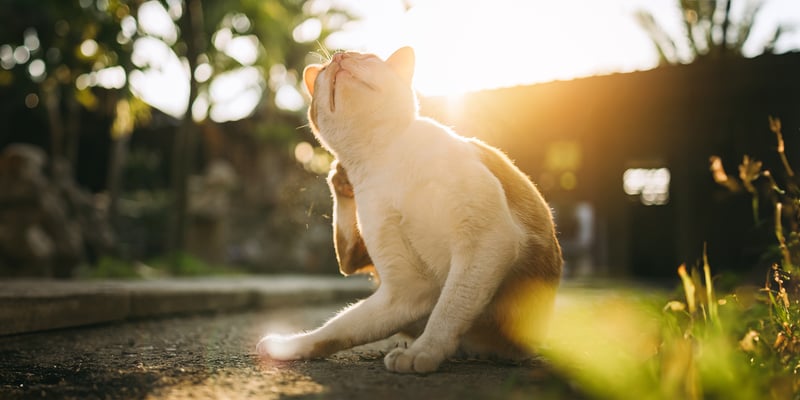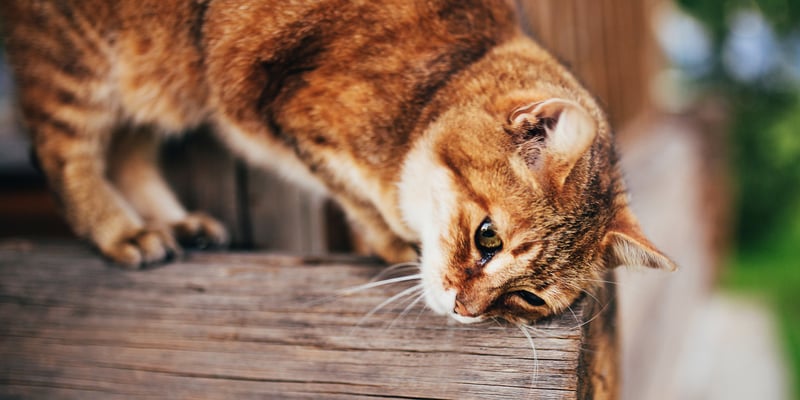Index:



Introduction
Though you might not yet realise it, understanding cat dandruff is essential for cat owners. Simply because it serves as a visible indicator of the overall health and well-being of your feline.
Dandruff in cats can be caused by various factors, including inadequate grooming, skin infections, allergies, or underlying health issues. By recognising and addressing cat dandruff, you can begin to proactively manage your cat's skin health - preventing potential discomfort and more severe dermatological conditions from developing.
Regular grooming, a balanced diet, and proper hydration are key components of maintaining a cat's skin health and preventing dandruff. In this article, we’re exploring the ways to recognise cat dandruff, why it’s important to acknowledge cat skin health and how to differentiate between dandruff and other skin conditions.
Underlying causes of cat dandruff



Diet and nutrition play a pivotal role in maintaining optimal skin health in cats. A well-balanced and high-quality cat food should provide essential nutrients, including fatty acids like omega-3 and omega-6, which are crucial for skin health. These fatty acids help nourish the skin, maintain its moisture balance, and contribute to a lustrous coat. If a cat's diet lacks these essential nutrients, it may result in dry, flaky skin and contribute to conditions like dandruff.
One common health issue leading to dandruff in cats is ringworm, a fungal infection that affects the skin, fur, and occasionally the nails. While it's not caused by a worm but rather a fungus, ringworm often presents as circular, red patches with flaky skin around the edges. This condition can cause dandruff-like symptoms and may lead to discomfort and itching for the affected cat. Ringworm is contagious and can be transmitted to other animals and humans, making prompt veterinary attention crucial for diagnosis and treatment to prevent its spread and alleviate the associated skin issues.
Dry skin in cats can be influenced by various environmental factors. Indoor conditions with low humidity, particularly in colder or heated environments, contribute to skin dehydration. Excessive bathing or the use of harsh grooming products can strip the skin of natural oils, leading to flakiness. Allergens like pollen, dust mites, and certain cleaning products can trigger allergic reactions, resulting in dry and irritated skin.
If your cats venture outdoors in a town or city, environmental pollutants, such as cigarette smoke, can exacerbate skin issues even further. As a cat owner, you can mitigate these factors by maintaining appropriate humidity levels, providing a balanced diet, using gentle grooming products, and seeking veterinary guidance if dry skin persists, ensuring a holistic approach to your cat's skin health.
Home care strategies



To maintain a dandruff-free coat in your cat, effective grooming techniques are essential. Regular brushing helps distribute natural oils, preventing the buildup of dead skin cells that can contribute to dandruff. Use a cat-specific brush or comb that suits your cat's coat type to remove loose fur and stimulate blood flow to the skin. Bathing, if necessary, should be done with a moisturising cat shampoo to prevent excessive dryness.
Diet plays a crucial role in cat skin health. Ensure your cat receives a well-balanced, high-quality cat food that contains essential nutrients, including omega-3 and omega-6 fatty acids. These fatty acids contribute to a healthy coat and skin, helping to prevent dryness and dandruff. Consider providing a diet with animal-based proteins, as they contain vital amino acids necessary for skin health.
Supplements and vitamins can also support cat skin health. Omega-3 fatty acid supplements, like fish oil, can be beneficial for maintaining skin moisture and reducing inflammation. Vitamin E is another supplement that aids in skin health and can be incorporated into your cat's diet under veterinary guidance.
Proper hydration is crucial for preventing dry skin in cats. Ensure your cat has access to clean, fresh water at all times. Hydration supports overall skin health and helps maintain the skin's elasticity, reducing the likelihood of dandruff.
In addition to dietary considerations, providing a stimulating and stress-free environment for your cat further contributes to their overall well-being and skin health. If dandruff persists or worsens, consult with a veterinarian to rule out underlying health issues and receive tailored advice for your cat's specific needs.
Professional care and treatments



If you observe any concerning signs or red flags, we recommend taking your cat to the vet. Worrying signs and symptoms include:
Persistent itching
Excessive scratching and grooming
Hair loss
Redness
Inflammation
Sores
Scabs
Changes in the colour or texture of the skin
If your cat is exhibiting behavioural changes or if you notice the presence of lumps or bumps on the skin, it's crucial to seek professional advice. All Waggel members get access to free online vet care any time of day with Joii. It’s easy to sign up, just visit their website for more information.
During a veterinary visit, your vet will conduct a thorough examination of your cat's skin, looking for signs of infections, allergies, parasites, or underlying health issues.
Diagnostic tests, such as skin scrapings, cultures, or blood work, may be recommended to pinpoint the cause of the skin problems. Treatment will depend on the specific diagnosis. It may include topical or oral medications for infections, anti-inflammatory drugs for allergies, or parasite control measures.
In cases of underlying health issues contributing to skin problems, addressing the primary medical condition will be a priority. Your vet will provide specific guidance on at-home care, grooming practices, and, if necessary, dietary adjustments to promote skin health and prevent future issues. Regular follow-up appointments may be recommended to monitor progress and adjust the treatment plan as needed.
Preventative measures



To prevent dandruff and dry skin in your cat, establish a routine care regime that includes regular grooming. Brush your cat's fur with a cat-specific brush or comb to remove loose hair and distribute natural oils. If your cat enjoys it, consider occasional baths using a mild, moisturising cat shampoo.
Ensuring your cat has a balanced diet with essential nutrients, including omega-3 and omega-6 fatty acids, will help to promote healthy skin. As will providing a clean, fresh water source to keep your cat well-hydrated - this is crucial for preventing dry skin.
Regular veterinary check-ups play a vital role in preventing and addressing skin issues. These check-ups allow your vet to detect potential problems early, provide vaccinations, and offer guidance on maintaining optimal skin health. The vet can also advise on suitable preventive measures, such as flea control, to minimise the risk of skin-related issues.
Creating a stress-free environment is essential for your cat's overall well-being and their skin. Provide safe hiding spots, comfortable bedding and vertical spaces (like cat trees) to offer a sense of security.
Use pheromone diffusers or sprays to create a calming atmosphere, especially during stressful events like vet visits or changes in the home environment. Establish a consistent routine for feeding, play, and grooming to give your cat a sense of predictability. Minimise loud noises and provide quiet retreats for relaxation. Ensuring your cat feels secure and content in their environment positively impacts their mental and physical health, reducing the likelihood of stress-related skin issues.
Product recommendations



In the UK, there are several cat-friendly shampoos available for various skin and coat conditions. When selecting a topical shampoo for your cat, it's important to choose products specifically designed for feline use to ensure they are safe and effective.
Here are some examples of cat shampoos commonly available:
MalAcetic Shampoo:
MalAcetic is a medicated shampoo suitable for cats with skin issues such as dandruff, yeast infections, or bacterial infections.
Anicura Cat Shampoo:
Anicura Cat Shampoo is a high-quality natural pet shampoo, made from plant oils and extracts. It’s perfect for all cats, including cats prone to itchy skin, sensitive skin, dry and flaky skin, eczema, feline dermatitis and skin allergies.
Johnson's Veterinary Tea Tree Skin Calm Shampoo:
Johnson's Veterinary Tea Tree Skin Calm Shampoo is designed to soothe and calm irritated skin, making it suitable for cats with mild skin issues.
Always follow the usage instructions provided on the product and consult with your veterinarian before using any new shampoo, especially if your cat has specific skin concerns. If your cat's skin issues persist or worsen, seeking professional veterinary advice is crucial for a proper diagnosis and treatment plan tailored to your cat's individual needs.
Common mistakes to avoid



To avoid over-bathing your cat, limit baths to when necessary, such as if your cat gets particularly dirty or has a skin condition that requires bathing. Cats generally groom themselves effectively, so excessive bathing can strip their skin of natural oils, leading to dryness. Use cat-specific shampoos designed for their skin pH, and always follow product instructions.
Using human products on cats can worsen skin issues due to differences in skin pH levels between humans and cats. Human shampoos or soaps may contain ingredients that are too harsh for a cat's sensitive skin, leading to irritation, dryness, or an imbalance in the skin's natural flora. Stick to products specifically formulated for feline use to ensure they are gentle and safe.
In terms of diet, avoid feeding your cat foods high in fillers, artificial additives, or lacking essential nutrients. A balanced, high-quality cat food with adequate levels of omega-3 and omega-6 fatty acids contributes to skin health. Some cats may have sensitivities to certain ingredients, so observe how your cat reacts to different foods and consult your veterinarian if you notice any adverse reactions or changes in skin condition.
Conclusion
To eliminate cat dandruff, you should focus on regular grooming, using cat-specific brushes to distribute natural oils and prevent the buildup of dead skin cells. Choose mild, moisturising cat shampoos for occasional baths and ensure a well-balanced diet rich in essential nutrients, including omega-3 and omega-6 fatty acids, to promote healthy skin.
Regular veterinary check-ups are crucial to detect and address skin issues early, and as a cat owner, you should seek professional advice if you notice persistent itching, redness, or other signs of skin problems. Creating a stress-free environment with predictable routines, safe hiding spots, and calming pheromones will also help to contribute to your cat’s overall health.
FAQs
What is cat dandruff and why does it occur?
Cat dandruff is the presence of small, white flakes on a cat's fur, indicating dry or flaky skin. It occurs due to various factors, including dehydration, poor nutrition, inadequate grooming, or underlying health issues.
How can I tell if my cat has dandruff or a more serious skin condition?
If the dandruff is occasional and not accompanied by redness, sores, or behavioural changes, it is likely a mild issue. However, persistent symptoms or additional concerning signs may indicate a more serious skin condition, requiring veterinary attention.
When should I be concerned about my cat's dry skin?
Concerns about dry skin in cats arise when there is persistent itching, redness, inflammation, or behavioural changes. If these signs are present, consulting with a veterinarian is advisable for a proper diagnosis and treatment plan.
Can cat dandruff be prevented, and if so, how?
Cat dandruff can be prevented by maintaining a balanced diet with essential nutrients, regular grooming to distribute natural oils, and providing a stress-free environment. Ensuring proper hydration and addressing any underlying health issues also contribute to prevention.
Waggel Pet Insurance
Need more help? You're in luck if you're a Waggel Pet Insurance member. Along with our excellent coverage, we offer access to a 24/7 online vet to answer all your sticky questions, especially if you need grooming assistance.
Not a member? Why not get a quote now and cover your furry friend for a range of illnesses, all while enjoying our amazing perks and rewards.
Want more like this?
Get updates from us with helpful info, advice, answers to frequently asked questions and much more.
Index:
Related posts:
Get your quote
Along with our excellent coverage, we offer access to a 24/7 online vet to answer all your sticky questions.





